Hydroponics is the technique of growing plants with the use of water, nutrients, and a growing medium. This is a method of gardening that does not use soil and depends only on water to provide nutrients to the plants. Hydroponic systems use different types of growing media like coconut coir, vermiculite, perlite, and more instead of soil. Getting started in hydroponics can be a bit confusing and intimidating at first. Selecting the most suitable hydroponic equipments, figuring out how they work, when to grow and what plants to grow can be quite a challenge. For Canadians who love indoor gardening, there is no dearth of choices in hydroponics equipments. Many suppliers like Canada Grows Indoors LLC offer a wide range of hydroponic products to suit your space and budget. However, it is best to find out which system is the best and most suitable for you before splurging on one.
Types of Hydroponics Systems
There are six basic types of hydroponics systems available in the markets today. These are:
1. Wick Systems

The wick system is the most simple and passive system. The plants are placed in an absorbent growing medium. A nylon wick runs from the plants to a reservoir of nutrient solution. This system works well for small herbs but is unsuitable for large plants. When used with large plants, they may use up the nutrient solution faster than the wicks can supply it.
2. Deep Water Culture (DWC)
In this system the plants, placed in net pots, are suspended in nutrient solution and air is provided directly to the roots with an air stone or diffuser. It is suitable for plants with large roots and water loving plants like lettuce. It is inexpensive and simple but unsuitable for long-term plants.
3. Nutrient Film Technique (NFT)

In NFT systems plants are placed in a growing tray with no growing medium, just air. The nutrient solution is pumped into the tray constantly and flows over the roots of the plants before draining into the reservoir. They are susceptible to power outages and pump failures. The roots dry out very rapidly when the flow of nutrient solution is interrupted..
4. Ebb and Flow System
This system uses a submerged pump connected to a time to provide nutrient solution to the grow tray at regular intervals. When the timer shuts the pump off the nutrient solution flows back into the reservoir. This versatile system can work with a variety of growing medium but is susceptible to power outages, pump and timer failures.
5. Aeroponics

In this system the plants are suspended in the air and nutrient solution is sprayed over their root system by pipes fitted with mist nozzles. A short cycle timer runs the nutrient pump for a few seconds every few minutes. As the roots are exposed to the air, they can dry out quickly if the misting cycles are interrupted.
6. Drip Systems
Here the plants are placed in a growing tray with drip lines connecting the tray to reservoir. Submerged pump controlled by timer pumps the nutrient onto each plant’s base by the drip lines. They are durable and cheap with more control over the watering schedule. However, they may be unsuitable for a smaller garden.
There are many benefits and drawbacks of each of these systems. However, you should select what is best for you based on the size of your garden, the plants you grow, and the amount of time and care you can provide to these plants.






